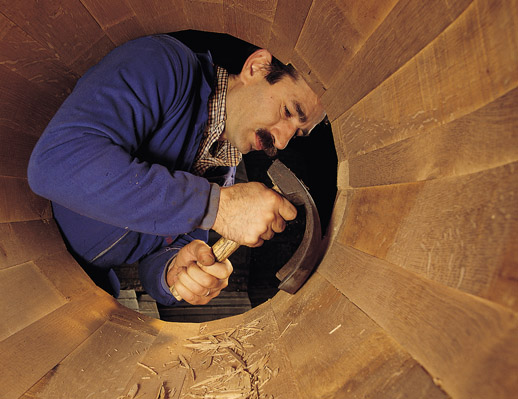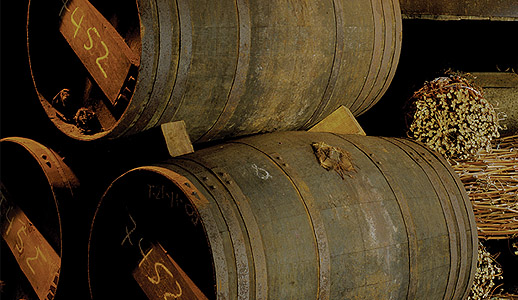 Not much has changed at the historic R. Lopez de Heredia winery since its beginnings in the 1880’s. Steeped in tradition and practices started by founder Don Rafael Lopez de Heredia y Landeta, the winery uses only estate grown fruit, natural yeasts, long aging in wood and no filtration at bottling.
Not much has changed at the historic R. Lopez de Heredia winery since its beginnings in the 1880’s. Steeped in tradition and practices started by founder Don Rafael Lopez de Heredia y Landeta, the winery uses only estate grown fruit, natural yeasts, long aging in wood and no filtration at bottling.The winery and vineyards, some of the first in the area, are located in the heart of Spain’s wine producing regions, the Alta Rioja. Unlike most of its competitors, now owned by outside investors, López de Heredia is owned by the family who founded it and every detail of its operation is handled with the same care and attention to detail as it has been since 1877. The bodega is now in the capable hands of the family’s youngest generation, Maria José, Mercedes, and Julio Cèsar and their wines continue to conjure the heritage, passion and prestige evoked by those of founder Don Rafael's "Supreme Rioja" .
Heredia was one of the earliest pioneers in Spain to adopt what were then the "modern" technologies of French winemaking, including the use of oak barrels for aging wine, and the French system of rackin
 g wine off its sediment. The winery continues to use oak barrels, and continues to recondition its own barrels with hand adzes, just as it has done for more than a century. Heredia also continues to use the painstakingly slow process of hand racking the wines using bronze spigots and oak funnels and buckets, a technique which has been abandoned by all but the most fastidious Bordeaux winemakers.
g wine off its sediment. The winery continues to use oak barrels, and continues to recondition its own barrels with hand adzes, just as it has done for more than a century. Heredia also continues to use the painstakingly slow process of hand racking the wines using bronze spigots and oak funnels and buckets, a technique which has been abandoned by all but the most fastidious Bordeaux winemakers.Patience takes on new meaning in the winery as wines from the Tondonia vineyard are regularly aged for at least sixty months in cask before bottling, and then several m
 ore years in the bottle under a thick shag carpet carpet of some of the most spectacular mold and cobwebs you could ever imagine in a wine cellar. Such extended ageing in neutral oak casks, in addition to eliminating the need for filtration, imparts a special character to these wines, and keeping the bottles amongst the mold apparently tends to prevent insect damage to the corks and preserve humidity.
ore years in the bottle under a thick shag carpet carpet of some of the most spectacular mold and cobwebs you could ever imagine in a wine cellar. Such extended ageing in neutral oak casks, in addition to eliminating the need for filtration, imparts a special character to these wines, and keeping the bottles amongst the mold apparently tends to prevent insect damage to the corks and preserve humidity.López de Heredia’s greatest wines are their two red Gran Reservas, Viña Tondonia and Viña Bosconia, aged 6 to 8 years in immaculate old barrels, which mellows the fruit, allows for natural clarification, and gives the wines a wonderful complexity. But even after these Gran Reservas are bottled, they’re not ready for sale; López de Heredia often keeps them a decade more before shipping a bottle.

Tondonia, Gravonia, and Bosconia refer to single-vineyard designated sites from which the winery grows all their fruit. The blends from year-to-year do not vary much: Tondonia whites are made (generally speaking) from 85% Viura, 10% Malvasia, and 5% Garnacho Blanco.
The Tondonia reds are a blend of 75% Tempranillo, 15% Garnacha (Grenache), and 10% Manzuela and Graciano, the classic Rioja proportions. The backbone is provided by Tempranillo since it is the most balanced varietal in Rioja. Its ageing-capabilities and alcohol content are derived from the Garnacha, while the acidity and color come from the Graciano and Manzuela grapes. Of the last two varieties, Graciano is a high-yielding vine in which the grapes never reach full maturity, while Manzuela has a very long ripening cycle and also rarely reaches maturity; both therefore provide the acidity for which Lopez wines are famous. Gran Reserva wines are chosen especially for particularly great vintages.
If you haven’t tasted traditional style Rioja, meaning no chemicals, no pesticides, no chaptalization, no machines, only hand-harvesting, only hand-racking with oak funnels, and 4 barrel-makers on staff, etc., etc., Lopez should be at the top of your list. And we are offering you an opportunity to not only taste the wines, but to meet Marie Lopez de Heredia at Swirl on Tuesday, May 12 at 6:30 pm! $10, reservations required, call 504.304.0635 or click here to Sign Me Up!
Here is a great video interview with Maria Lopez de Heredia about the winery and their philosophy on traditional winemaking:
No comments:
Post a Comment